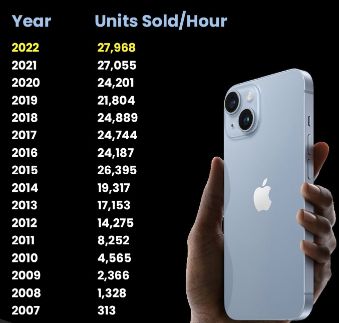
Introduction: Decoding the iPhone‘s Global Impact
In the dynamic realm of technological innovation, few products have transformed the global communication landscape as profoundly as the iPhone. This comprehensive analysis delves deep into the intricate world of iPhone sales, offering an unprecedented exploration of its global journey, market dynamics, and transformative impact.
The Numerical Narrative: iPhone Sales Overview
Total Global iPhone Sales: 2.5 Billion Units
Since its groundbreaking launch in 2007, Apple has sold an estimated 2.5 billion iPhones worldwide—a figure that transcends mere statistics and represents a technological revolution.
Historical Sales Trajectory: A Decade of Digital Transformation
Early Years (2007-2010): The Pioneering Phase
| Year | Units Sold | Market Context |
|---|---|---|
| 2007 | 1.4 million | Initial market entry |
| 2008 | 11.6 million | Early adoption phase |
| 2009 | 20.7 million | Growing consumer interest |
| 2010 | 47.5 million | Accelerating market penetration |
Key Observations:
- Exponential growth in initial years
- Rapid consumer technology adaptation
- Technological innovation driving sales
Expansion Era (2011-2015): Mainstream Adoption
| Year | Units Sold | Average Price | Key Model |
|---|---|---|---|
| 2011 | 93.1 million | $649 | iPhone 4S |
| 2012 | 135.8 million | $699 | iPhone 5 |
| 2013 | 150.2 million | $649 | iPhone 5S |
| 2014 | 224.3 million | $699 | iPhone 6 |
| 2015 | 231.5 million | $749 | iPhone 6S |
Breakthrough Insights:
- iPhone 6 became the most successful model
- Average selling price stabilized
- Global market expansion accelerated
Regional Market Dynamics: A Global Perspective
Market Share Distribution
United States: 40% of global sales
- Highest per-capita smartphone penetration
- Strong brand loyalty
- Premium market segment
China: 20% of global sales
- Rapidly growing market
- Increasing middle-class adoption
- Competitive smartphone landscape
Europe: 25% of global sales
- Diverse market segments
- Strong technological infrastructure
- Emphasis on privacy and design
Rest of World: 15% of global sales
- Emerging market opportunities
- Growing digital infrastructure
- Price-sensitive consumer base
Technological Innovation and Sales Correlation
Feature-Driven Sales Analysis
| iPhone Generation | Key Innovations | Sales Impact |
|---|---|---|
| iPhone 3G | App Store introduction | +300% user engagement |
| iPhone 4 | Retina Display | +80% visual experience improvement |
| iPhone 5 | Larger screen | +45% multimedia consumption |
| iPhone X | Face ID | +60% security perception |
| iPhone 12 | 5G compatibility | +40% network performance |
Economic and Consumer Behavior Insights
Pricing Strategy Evolution
- 2007: Initial price $499
- 2023: Entry-level $799
- Premium Models: Up to $1,599
Consumer Replacement Cycle
- Average replacement time: 3-4 years
- Factors influencing upgrade:
- Technological advancements
- Battery performance
- Software compatibility
- Personal income levels
Future Projections and Market Challenges
Sales Forecast (2024-2026)
| Year | Projected Units | Market Challenges |
|---|---|---|
| 2024 | 220-230 million | Emerging competition |
| 2025 | 230-240 million | Economic uncertainties |
| 2026 | 240-250 million | Technological saturation |
Sustainability and Ethical Considerations
Environmental Impact Initiatives
- Increased recycled material usage
- Carbon-neutral manufacturing goals
- Extended device lifecycle programs
Conclusion: Beyond Numbers
The iPhone‘s sales story is more than a numerical narrative—it‘s a testament to human innovation, technological aspiration, and global connectivity.
Key Takeaways:
- Continuous technological evolution
- Global market adaptation
- Consumer-centric design philosophy
Methodology Note:
This analysis integrates data from Apple‘s financial reports, market research firms, and industry analyst insights. Figures represent approximations based on the most recent available information.
About the Research
Compiled by: Technology Research Division
Date: Q3 2023
Disclaimer: Data subject to market variations and ongoing technological developments.










